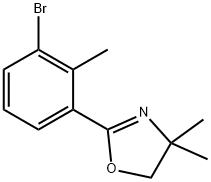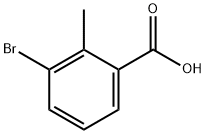
2-(3-BroMo-2-Methylphenyl)-4,5-dihydro-4,4-diMethyl-oxazole synthesis
- Product Name:2-(3-BroMo-2-Methylphenyl)-4,5-dihydro-4,4-diMethyl-oxazole
- CAS Number:868975-15-9
- Molecular formula:C12H14BrNO
- Molecular Weight:268.15

21900-48-1
30 suppliers
$60.00/100mg

124-68-5
533 suppliers
$4.76/25g

868975-15-9
8 suppliers
$165.00/100mg
Yield:868975-15-9 217 g
Reaction Conditions:
Stage #1: 3-bromo-2-methylbenzoic acid chloride;2-Amino-2-methyl-1-propanol in dichloromethane at 10 - 20; for 3.75 h;
Stage #2: with thionyl chloride at 20;
Steps:
To a 1 L, one-necked flask equipped with a magnetic stir bar and reflux condenser, was added 3-bromo-2-methylbenzoic acid 1 (200 g, 0.93 mol) and thionyl chloride (202 mL, 2.79 mol). The reactor was attached to aqueous NaOH solution scrubber (the amount of NaOH was not listed above) and heated to 76° C. for 90 min. At this point, all the solid had dissolved. GC analysis indicated that the reaction was complete. The batch was cooled to ambient temperature and concentrated under reduced pressure to give 3-bromo-2-methylbenzoyl chloride as a light brown oil. This material was dissolved in anhydrous CH2Cl2 (350 mL) and transferred to an addition funnel. This solution was added drop wise to a solution of 2-amino-2-methyl-1-propanol (182.4 g, 2.05 mol) in anhydrous CH2Cl2 (1.0 L) over 45 min. During the addition, the internal temperature was kept between 10° C. to 20° C. by cooling with an ice-water bath. The addition funnel was rinsed with anhydrous CH2Cl2 (50 mL). The batch was stirred at ambient temperature for 3 h. GC analysis indicated that the reaction was complete. The salts were filtered-off and the filter cake was rinsed with CH2Cl2 (1 L). The filtrate was washed with sat. aq NaHCO3 (500 mL, prepared from 200 g NaHCO3 and 1.6 L tap water) and brine (500 mL, prepared from 750 g NaCl and 1.5 L tap water). The separated organic layer was dried over Na2SO4 (400 g) and filtered. Material transfer and filter cake rinsing was completed with CH2Cl2 (1 L). The filtrate was concentrated under reduced pressure. To the resulting residue was slowly added thionyl chloride (302 mL, 4.16 mol). Exothermic reaction occurred. The reactor was attached to aqueous NaOH solution scrubber (the amount of NaOH was not listed above) and the batch was stirred for 2 h upon completion of the addition. GC analysis indicated that the reaction was complete. Thionyl chloride was removed under reduced pressure. The residue was cooled with an ice-water bath. MeOH (100 mL) was slowly added (very exothermic), followed by 20 wt % NaOH solution (600 mL, prepared from 200 g NaOH and 0.8 L tap water). The pH of the reaction mixture was determined to be 14. Tap water (1 L) was added, and the batch was stirred until most of the solids dissolved. The mixture was extracted with MTBE (800 mL×3). The organic layers were combined, washed with brine (500 mL), dried over Na2SO4 (322 g), and concentrated under reduced pressure. The residue was purified by passage through a silica-gel plug (1 kg silica gel in a 3 L filter funnel loaded with 2 L of hexane) eluted with 15% EtOAc/hexane (7.5 L). The first 5.5 L of eluent contained 2. Concentration under reduced pressure afforded 217 g (87%) of 2 as an orange oil. HPLC indicated its purity was 96.5 A %. LCMS (m/z) 268.14 (M++1, 79Br), 270.03 (M++1, 81Br). 1H NMR (400 MHz, CDCl3) δ 1.40 (6H, s), 2.61 (3H, s), 4.09 (2H, s), 7.06 (1H, dd, J=8.4, 7.2 Hz), 7.60 (1H, d, J=7.2 Hz), 7.62 (1H, dd, J=8.4, 1.2 Hz). 13C NMR (100 MHz, CDCl3) δ 20.9, 28.5 (2C), 68.2, 79.0, 126.7, 126.8, 129.0, 130.3, 134.7, 137.9, 162.3.
References:
US9193690,2015,B2 Location in patent:Page/Page column 2; 3

76006-33-2
311 suppliers
$10.00/5g

124-68-5
533 suppliers
$4.76/25g

868975-15-9
8 suppliers
$165.00/100mg

76006-33-2
311 suppliers
$10.00/5g

868975-15-9
8 suppliers
$165.00/100mg